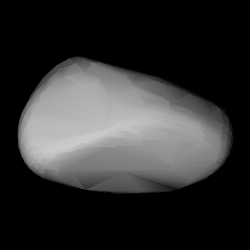518 Halawe
Topic: Astronomy
 From HandWiki - Reading time: 1 min
From HandWiki - Reading time: 1 min
 Modelled shape of Halawe from its lightcurve | |
| Discovery | |
|---|---|
| Discovered by | Raymond Smith Dugan |
| Discovery site | Heidelberg |
| Discovery date | 20 October 1903 |
| Designations | |
| (518) Halawe | |
| 1903 MO | |
| Orbital characteristics[1] | |
| Epoch 31 July 2016 (JD 2457600.5) | |
| Uncertainty parameter 0 | |
| Observation arc | 112.49 yr (41086 d) |
| |{{{apsis}}}|helion}} | 3.1107 astronomical unit|AU (465.35 Gm) |
| |{{{apsis}}}|helion}} | 1.9544 AU (292.37 Gm) |
| 2.5325 AU (378.86 Gm) | |
| Eccentricity | 0.22829 |
| Orbital period | 4.03 yr (1472.1 d) |
| Mean anomaly | 21.1970° |
| Mean motion | 0° 14m 40.38s / day |
| Inclination | 6.7288° |
| Longitude of ascending node | 203.955° |
| 117.567° | |
| Physical characteristics | |
| Mean radius | 7.815±0.9 km |
| Rotation period | 14.310 h (0.5963 d) |
| Geometric albedo | 0.2880±0.079 |
| Absolute magnitude (H) | 11.00 |
Halawe (minor planet designation: 518 Halawe) is a minor planet orbiting the Sun. It is named after the Middle Eastern confectionery halva.
References
External links
- 518 Halawe at AstDyS-2, Asteroids—Dynamic Site
- 518 Halawe at the JPL Small-Body Database
 |
Licensed under CC BY-SA 3.0 | Source: https://handwiki.org/wiki/Astronomy:518_Halawe13 views | Status: cached on October 22 2024 04:39:01↧ Download this article as ZWI file
 KSF
KSF